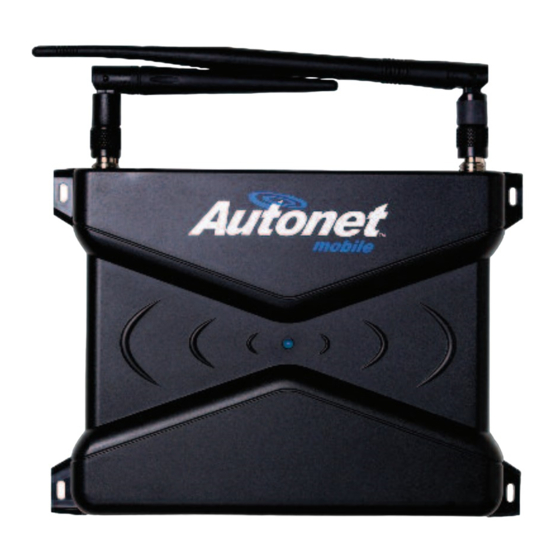Autonet Mobile ANMASPLS-03 Panduan Pengguna - Halaman 10
Jelajahi secara online atau unduh pdf Panduan Pengguna untuk Router Nirkabel Autonet Mobile ANMASPLS-03. Autonet Mobile ANMASPLS-03 16 halaman. In-car router

• Your In-Car Router or any accessory does not operate normally
in accordance with the instructions contained in any guide provided
by Autonet Mobile, Inc.; and
• Your In-Car Router or any accessory exhibits a distinct change in
performance.
All servicing of the In-Car Router or any accessory should be undertaken
only by qualified service personnel. Do not attempt to disassemble, mod-
ify, or repair the In-Car Router or any accessory yourself.
Adjustments
Adjust only those controls for the In-Car Router that are discussed in
the instructions contained in any guide provided by Autonet Mobile, Inc.
An improper adjustment of other controls for the In-Car Router may re-
sult in damages and may require extensive work by a qualified technician
to restore the In-Car Router or any accessory, as the case may be.
Rough Treatment
Do not drop, strike or shake severely the In-Car Router. Such actions may
damage its internal circuit boards.
Antenna Care
Only use any supplied integral antenna with the In-Car Router. Unautho-
rized antenna modifications, or attachments could damage the In-Car
Router and may violate U.S. Federal Communications Commission (FCC)
regulations. No one should hold the antenna or let it come into contact
with his or her body when the In-Car Router is in use. Do note use the
In-Car Router if the antenna is damaged. If a damaged antenna touches
skin, it may cause a slight burn.
Local Laws
Drivers and their passengers are responsible for determining and com-
plying with any local laws affecting the use of the In-Car Router. Accord-
ingly, you should familiarize yourself with any applicable laws in jurisdictions
where you use the In-Car Router.Always obey those laws.
Exposure to Radio Frequency Signals
the In-Car Router is a low power radio transmitter and receiver.When it
is turned on, it sends out and receives RF signals.The In-Car Router com-
plies with FCC guidelines respecting safe levels of RF exposure for handled
16
wireless devices, which in turn are consistent with the following safety
standards previously set by certain standards bodies:
• ANSI/IEEE C95.1-1999, IEEE Standard for Safety Levels with Respect
to Human Exposure to Radio Frequency Electromagnetic Fields,
3 kHz to 300 GHz;
• National Counsel on Radiation Protection and Measurements (NCRP)
Report 86, - 1986, Biological Effects and Exposure criterion for Radio
Frequency Electromagnetic Fields; and
• International Commission on Non-Ionising Radiation Protection
(ICNIRP) 1988, Guidelines for limiting exposure to time-varying
electric, magnetic, and electromagnetic fields (up to 300 GHz).
To maintain compliance with FCC exposure guidelines, use only acces-
sories supplied or approved by Autonet Mobile, Inc.
Specific Absorption Rate Data
The In-Car Router meets U.S. government requirements for exposure to
radio waves. the In-Car Router is a radio transmitter and receiver. It is de-
signed and manufactured not to exceed the emission limits for exposure
to RF energy set by the FCC.These limits are part of comprehensive guide-
lines and establish permitted levels of exposure to RF energy for the gen-
eral population. These guidelines are based on standards that were
developed by independent scientific organizations through periodic and
thorough evaluation of scientific studies.The standards include a substan-
tial safety margin designed to assure the safety of all persons, regardless of
age and health.
FCC Compliance Statement
This equipment has been tested and found to comply with the limits for a
Class A digital device, pursuant to part 15 of the FCC Rules.These limits are
designed to provide reasonable protection against harmful interference
when the equipment is operated in a commercial environment.This equip-
ment generates, uses, and can radiate radio frequency energy and, if not in-
stalled and used in accordance with the instruction manual, may cause
harmful interference to radio communications. Operation of this equipment
in a residential area is likely to cause harmful interference in which case the
user will be required to correct the interference at his own expense.
Changes or modifications not expressly approved by the party responsible
for compliance could void the user's authority to operate the equipment.
17
